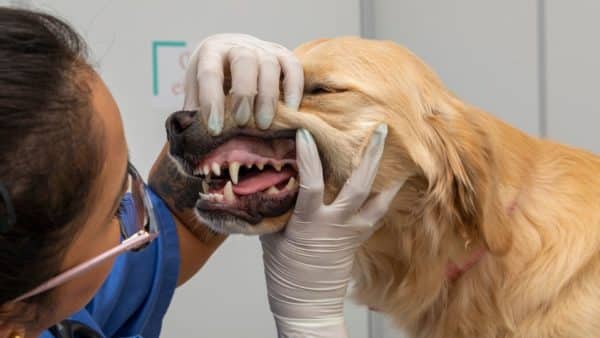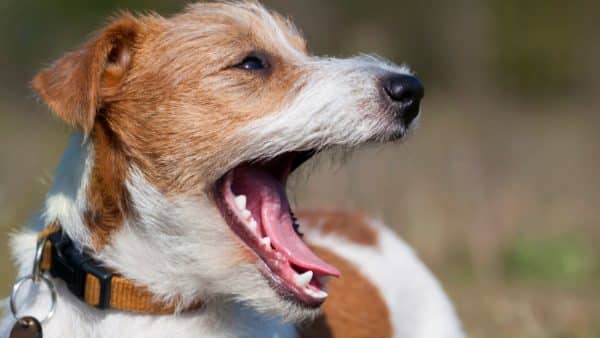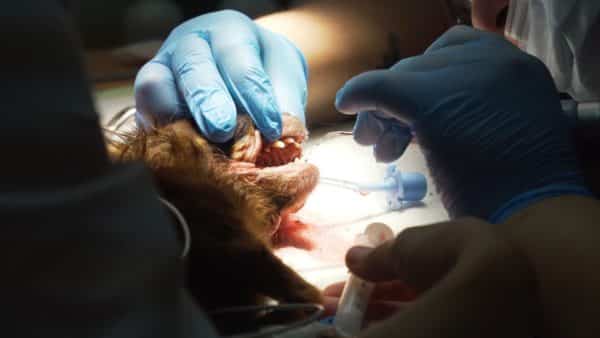

Keeping your canine friend’s oral health up to par can be quite important when it comes to preventing other conditions such as tartar and plaque buildup. Your dog’s mouth is the first barrier that they have at their disposal as it ensures that no potentially dangerous germs go right into their bloodstream.
When your dog is hungry, you feed him but making sure his mouth is clean after the feeding is just as important as ensuring that he is well-fed.
Most dogs begin to show signs of periodontal disease by the time they are three years of age. Since your dog is supposed to live for at least a decade, it is your responsibility, as the pet’s owner, to make sure that you tend to a dental cleaning routine.
Ideally, you should take your pooch to the vet hospital for a dental cleaning appointment at least once every year, although a professional one would be much better once every six months. Even if he seems healthy, it’s difficult to tell if he is happy with his oral health, so it’s important to have regular visits with the vet.
In today’s article, we are looking at everything that dog dental care entails and several means of keeping your dog’s teeth and gums as healthy for as long as possible, especially in-between appointments at the veterinary clinic.
Preventing dental disease is not easy, especially since most dogs do not appreciate having their teeth brushed. In case you did not know, plaque does not take too long to become hard — just as little as forty-eight to seventy-two hours.
Once plaque becomes hard, you have no way of removing it yourself, at home, and without getting your pup extremely stressed. So, therefore, you will have to go to dental cleanings at the animal hospital on a regular basis when you could have just made sure to brush your dog’s teeth once every two to three days, instead.
If you create a teeth cleaning routine, not only will you help keep your dog’s dental health in check for many years to come, but you’ll also be able to prevent having to deal with extremely bad breath.
We recommend that you start brushing your pet’s teeth while it’s a puppy so it can be used to the routine. Even If your fur friend is a few years old already and has a receding gum line, and buildup of plaque, don’t fret.
Old dogs can learn new tricks. They can become friends with a pet toothbrush, toothpaste, dental treats, dog mouth wash, chew toys, or oral sprays so long as you maintain a consistent routine.

Keeping your dog’s teeth healthy can be done thanks to a schedule that you’ve created. Make sure you first find a comfortable and quiet place where you can tend to the dog’s dental care procedures. Get your dog used to the idea that they will have their mouth handled on a daily basis.
Leave your dog to inspect the tools you intend to use, such as the toothpaste, the toothbrush, dog dental picks, or even the chew toy you intend to reward your pet for being such a good boy or girl afterward. Make sure to add a water additive to keep your dog’s teeth as fresh as can be in between the cleanings.
Always begin with one specific section of the mouth at a time. Some veterinary professionals recommend starting with the front teeth and then moving to the sides. For some pets, it might not be the same and they could prefer it the other way around.
If your dog starts to show signs of stress, it might be a sign that you are cleaning its teeth too fast. Stop for a while, allow your dog to re-become comfortable, and then continue.
If your dog’s gums begin to bleed, stop altogether and go see a professional and find out what’s wrong. Bleeding is never a good sign and while it might be manageable, you might have to change the products that you use, at least for a while.

According to the American Veterinary Medical Association, daily brushing is the right way of going about things. However, it takes time for a dog to become used to the task, so at first, you can just brush your dog’s teeth once every two to three days and then turn it into a daily habit.
Even though there are many products marketed for the purpose of keeping your dog’s teeth clean and healthy, the fact of the matter is that not all of them work or have safe ingredients. Ask your vet about what products they recommend and what the best toothbrush can be for your specific dog breed.
Owners should know that although all dogs have the same number of teeth and basic configuration, the pet toothbrush they choose should also depend on their size. You cannot use the same brush for a Saint Bernard as you would for a Chihuahua — for obvious reasons.
Pet teeth cleaning products such as toothpaste and dental sticks are particularly made with delicious ingredients so that your dog doesn’t begin to hate the dental routine you have created. Some examples of flavors that your pup might enjoy are chicken or beef, but also peanut butter.
Protecting your dog’s teeth from buildups can be done with regular tooth brushing, but it can also be a result of using the right water additives.
In fact, most products that are marketed as mouthwashes for dogs contain ingredients that fight tartar buildup, remove bacteria that leads to the production of plaque, and as a bonus, also get rid of your dog’s bad breath.
Another option you have at your disposal when it comes to ensuring great oral health and preventing buildups is using a canine oral spray. Like mouthwash, a dog mouth spray usually contains substances that kill plaque-producing bacteria.
However, this does not mean that regular teeth cleanings are going to be less necessary in that you will still have to brush your dog’s teeth at least once every two to three days. After all, most humans brush their teeth and tend to their oral care routines twice a day. Why shouldn’t your pup deserve the same consideration as most humans?
Bid farewell to tartar buildup with our selection of top products crafted for effective dog tartar removal. Designed to tackle stubborn plaque and maintain optimal oral hygiene, these products include dental chews, tartar control sprays, and specially formulated toothpaste. Combatting tartar is crucial for preventing dental issues,
While using a toothbrush, a dental spray, as well as a mouthwash for dogs is great, you can indirectly clean your dog’s teeth by using the right treats and toys.
Chew treats are made specifically to be a little abrasive so that they mechanically remove the plaque on your dog’s teeth.
Also, many chews these days combine the benefits of several different products into one. For example, omega chews can have an abrasive surface, too, thereby giving them teeth cleaning capabilities, and the same goes for allergy or hip & joint chews. But you should know that in the end, dog dental treats aren’t a replacer for toothbrushes and toothpaste cleanings.
Chew toys can be made of a variety of materials, some of which can keep your pup’s teeth clean more or less.
Whether chews are made of nylon, rubber, or rope, if your dog is a great chewer, why not take advantage of this feature and conveniently keep their dental health in check? After all, your pooch isn’t going to chew on your shoes or furniture, so that’s another benefit to consider.
The short answer to this question is a no. Dogs cannot use human toothpaste. Human toothpaste often has potentially dangerous ingredients, so dog owners should avoid using it.
Not only can human toothpaste contain a lot of xylitol or other artificial sweeteners, to which dogs don’t respond too well, but it can also contain menthol (which isn’t supposed to be swallowed) to which your dog might have a severe adverse reaction.
Although you might want your dog’s breath to be fresh, mint or menthol products are not the best for the purpose, and neither are eucalyptus ones. However, be aware that there are many common household foods that are toxic to your dog, so double-check anything you feed your pup.
If you know that you keep your dog’s teeth healthy with dog-specific products on a regular basis, you don’t have to worry about them developing dental disease or stinky breath too soon, for that matter.

As uncomfortable it might be to have to think about it, dogs sometimes have to have their teeth extracted just like humans do. Some of the most common causes of teeth extractions in our canine friends are the following:
Periodontal disease is another reason and it’s not just smelly and quite uncomfortable for your pooch – it also leads the way to sepsis. Fido is much more likely to develop a generalized infection if they’re suffering from periodontosis.
The extraction involves initial cleaning, at least an x-ray, the use of an anesthetic, and the actual surgery where the bad tooth is removed. There are several different techniques that a board-certified veterinary dentist can use for this purpose, but they are quite complicated.
When it comes to recovery, most dogs get back to their former selves in the course of 48 to 72 hours following the operation. Most vets recommend hospitalizing the patient so that they can be fed intravenously since they are not going to be able to use their mouths due to local pain.
When your dog comes home from a dental procedure as serious as that, be sure to have their living space as comfortable as can be. A cozy, calming blanket and a calming bed can ease the stress and help them in the recovery process.
In dogs whose periodontosis is so severe that it has affected all of their teeth, it sometimes makes more sense to extract all of them rather than to try to uselessly treat the disease (since periodontosis basically has no cure).
It might seem heartbreaking, but the truth is that many toothless dogs live a happy and healthy life for many years after the surgery. Luckily, pets are fully capable of feeding (granted, they have to receive a soft or liquid diet) even after they’ve undergone full mouth extractions.
Professional dental cleaning is excellent, but such an appointment usually involves painful procedures, such as the manual removal of tartar, which could cause gum soreness. Therefore, anesthesia is typically necessary for most such procedures as dogs are unwilling to withstand them otherwise.
And if you didn’t know, pets shouldn’t undergo procedures where anesthesia is used more often than once or twice a year (tops). Dental cleanings are by far the best at removing both tartar and plaque and preventing periodontosis.
Some dog breeds have a higher likelihood of developing oral health issues. As such, they have to get professional cleanings done more often. Here are some examples:
But how much does a dental appointment cost? Well, it differs largely on what your dog is supposed to have done. The average cost for teeth cleaning is somewhere in the range of $200 to $700 or more.
Owners should know that the cost can be much higher if your dog needs to be induced with anesthesia or if the veterinarian has to perform other procedures, such as x-rays, blood work, or if your dog has an infection and needs to receive specific medication for it.
But what are the signs that should convince you to take your pooch to the hospital for professional cleaning? Here are some:
If you notice any of these in your canine friend, contact your vet as soon as possible.
In the end, taking preventive measures such as using the right water additive, making sure your dog’s chewing on oral treats and toys, and practicing regular brushing can prevent a lot of general health and care problems and can also make the frequency of cleanings fewer.
Most of us train our dogs when they are puppies to jump up on furniture. We think it’s harmless (and easier than always lifting them), but for dogs, couches and beds are very high compared to the size of their bodies.
Every time they jump it compresses their back and applies enormous force to their joints.
It’s no wonder that an incredible 80% of dogs experience arthritis or joint pain by only 7 years old.
Luckily, there is a vet-recommended solution.
It’s the PawRamp by Alpha Paw. An adjustable ramp that allows dogs to safely get on and off couches and beds. PawRamp makes joining you in bed or on the couch effortless and fun.
As a bonus, you can use code SAVE35 to get $35 off the PawRamp today.

The medical, nutritional, or behavioral advice we provide is intended for informational and educational purposes only. Our editorial content is not a substitute for formal or personalized medical advice from a veterinary professional. Only board-certified veterinary specialists who have examined your pet should diagnose medical conditions, provide personalized treatment, or prescribe appropriate medication. For questions regarding your pet’s health, or if your pet is exhibiting signs of illness, injury, or distress, contact your veterinarian immediately. Never disregard professional medical advice or delay in seeking it because of something you have read on our site.